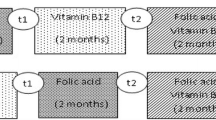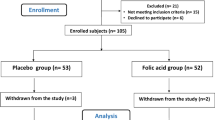Abstract
Background: Hyperhomocysteinemia is anindependent risk factor for cardiovascularevents. The aim of this study was to show theresults of the reduction of homocysteine in endstage renal failure patients on hemodialysis,as it is known, have higher levels ofhomocysteine than other groups of subjects.Methods: Plasma homocysteineconcentration was determined before and afterthe administration of vitamin B6 and folicacid in 12 patients (males : 6) on regulardialysis therapy. Mean monthly fasting serumconcentrations of total cholesterol (TCHOL),HDL-chol, LDL-chol and triglycerides (TRG) weredetermined for a period 68 months (12–120months) before and 26 months after theadministration of vitamin B6 and folicacid. Results: Mean serum concentrations forfolic acid and vitamin B12 before andafter the administration were: folic acid:5.03 ± 4.9 and 18.0 ± 19.2 ng/ml,(p < 0.0001) and B12 : 456 ± 257 and514.38 ± 307 pg/mL respectively). Plasmahomocysteine was reduced significantly afterthe administration of above drugs (from47 ± 14 to 29 ± 9 µmol/mL, p < 0.001).This reduction of homocysteine resulted in amodification of the patients' lipidemicprofile: Serum LDL-chol was decreasedsignificantly (119 ± 38 mg/dL to110 ± 35 mg/dL, p<0.005). TCHOL and TRG werealso decreased but not significantly(190 ± 45 mg/dL to 187 ± 43 mg/dL and116 ± 63 mg/dL to 108 ± 47 mg/dLrespectively)). Serum concentrations HDL-cholwere increased significantly (from42 ± 10 mg/dL to 47 ± 10 mg/dL, p < 0.001).The atherogenic index for cholesterol, LDL/HDL,was 1.6 times lower after the drugs receiving(before: LDL/HDL = 3.1 and after: LDL/HDL = 2.5,p < 0.001).Conclusions: These results indicate thatthe folate and vitamin B6 supplementationresulted in reduction of homocysteine levelsand improvement of lipidemic profile in regulardialysis patients.
Similar content being viewed by others
References
Arnadottir M, Brattstrom L, Simonsen O et al. The effect of high-dose pyridoxine and folic acid supplementation on serum lipid and plasma homocysteine concentrations in dialysis patients. Clin Nephrol 1993; 40: 236–240
Booth GL, Wang EE. Preventive health care, 2000 update: screening and management of hyperhomocysteinemia for the prevention of coronary artery disease events. The Canadian Task Force on Preventic Health Care. CMAJ 2000; 11: 21–29
Boston AG, Shemin D, Verhofen P et al. Elevated fasting total plasma homocystein levels and cardiovascular disease outcomes in maintenance dialysis patients: a prospective study. Arteriolscler Thromb Vasc Biol 1997; 17: 2554
Chauveau P, Chadefaux B.Hyperhomocysteinemia, a risk factor for atherosclerosis in chronic uremic patients. Kidney Int 1993; 43: 72–77
Choy PC, Mymin D, Zhu Q, Dakshinamurti K, O K. Athero-sclerosis risk factors: the possible role of homocysteine. Mol Cell Biochem 2000Apr;207(1–2): 143–148
Frauscher G, Karnaukhova E, Muehl A et al. Oral administra-tion of homocysteine leads to increased plasma triglycerides and homocysteic acid-additional mechanisms in homocysteine induced endothelial damage? Life Sci 1995; 57(8): 813-817
Werstuck GH, Lentz SR, Dayal S et al. Homocysteine-induced endoplasmic reticulum stress causes dysregulation of the cholesterol and triglyceride biosynthetic pathways. J Clin Invest 2001; 10: 1263–1273
Janssen MJ, van den Berg M, Stehouwer CD, Boers GH. Hyperhomocysteinaemia: a role in the accelerated athero-genesis of chronic renal failure? Neth J Med 1995; 46: 244–251
Manns BJ, Burgess ED, Hyndman ME et al. Hyperhomo-cysteiemia and the prevalence of atherosclerotic vascular disease in patients with end stage renal disease. Am J Kidney Dis 1999; 34: 669–677
McCully KS, Olszewski AJ, Vezeridis MP. Homocysteine and lipid metabolism in atherogenesis: effect of the homo-cysteine thiolactonyl derivatives, thioretinaco and thioreti-namide. Atheroscerosis 1990; 83: 197–206
McGregor D, Shand B, Lynn K. A controlled trial of the effect of folate supplements on homocysteine, lipids and hemorheology in end-stage renal disease. Nephron 2000; 85: 215–220
McKinley CM, McNulty H, McParthin J et al. Low-dose vitamin B-6 effectively lowers fasting plasma homocysteine in healthy elderly persons who are folate and riboflavin replete. Am J of Clin Nutr 2001; 73: 759–764
Molloy AM, Daly S, Mills JL et al. Thermolabile variant of 5, 10-methylenetetrahydrofolate reductase associated with low red-cell folates: implications for folate intake recommenda-tions. Lancet 1997; 349: 1591–1593
Moustapha A, Nalso A, Nahlawi M et al. Prospective study of hyperhomocysteinemia as an adverse cardiovascular risk factor in end stage renal failure. Circulation 1998; 97: 138–141
O K, Lynn EG, Chung YH et al. Homocysteine stimulates the production and secretion of cholesterol in hepatic cells. Biochim Biophys Acta 1998 Aug 28; 1393(2–3): 317–324
Olszewski AJ, Szostak WB. Homocysteine content of plasma proteins in ischemic heart disease. Atherosclerosis 1988; 88: 97–98
Olszewski AJ, McCully KS. Homocysteine content of lipo-proteins in hypercholesterolemia. Atherosclerosis 1991; 88: 61–68
Olszewski AJ, McCully KS. Homocysteine content of lipo-proteins in hypercholesterolemia. Atherosclerosis 1991 May; 88(1): 61–68
Olszewski AJ, Szostak WB, Bialkowska M et al. Reduc-tion of plasma lipid and homocysteine levels by pyridoxine, folate, covalamin, riboflavin, and troxerutin in atherosclerosis. Atherosclerosis 1991; 88(1): 978
Olszewski AJ, McCully KS. Homocysteine metabolism and the oxidative modification of proteins and lipids. Free Radic Biol Med 1993; 14: 683
Qujeq D, Omran TS, Hosini L. Correlation between total homocysteine, low-density lipoprotein cholesterol and high-density lipoprotein cholesterol in the serum of patients with myocardial infarction. Clin Biochem 2001Mar; 34(2): 97–101
Selhub J, Jacques PF, Wilson PWF et al. Vitamin status and intake as primary determinants of homocysteinemia in an elderly population. Jama 1993; 270: 2693–2698
Spence JD, Cordy P, Kortas C, Freeman D. Effect of usual doses of folate supplementation on elevated plasma homo-cysteine in hemodialysis patients: no difference between 1 and 5 mg daily. Am J Nephrol 1999; 19: 405–410
Stanford JL, Molina H, Phillips J et al. Oral folate reduces plasma homocysteine levels in hemodialysis patients with cardiovascular disease. Cardiovasc Surg 2000; 8(7): 567–571
Sunder-Plassmann G, Fodinger M, Buchmayer H et al. Effect of high dose folic acid therapy on hyperhomocysteinemia in hemodialysis patients: results of the Vienna multicenter study. J Am Soc Nephrol 2000; 11: 1106–1116
Weiss N, Feussner A, Hailer S et al. Influence of folic acid, pyridoxal phosphate and covalamin on plasma homocysteine levels and the susceptibility of low density lipoprotein to ex-vivo oxidation. Euro J Med Res 1999; 15: 425–432
Author information
Authors and Affiliations
Rights and permissions
About this article
Cite this article
Ziakka, S., Rammos, G., Kountouris, S. et al. The effect of vitamin B6 and folate supplements on plasma homocysteine and serum lipids levels in patients on regular hemodialysis. Int Urol Nephrol 33, 559–562 (2001). https://doi.org/10.1023/A:1019559328424
Issue Date:
DOI: https://doi.org/10.1023/A:1019559328424




